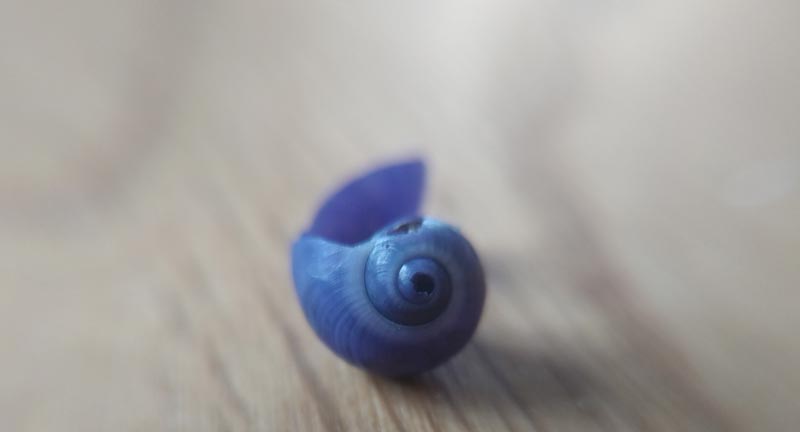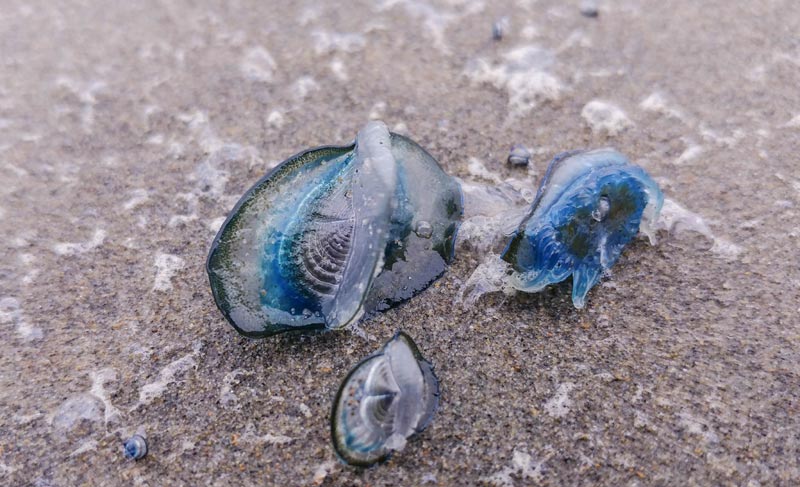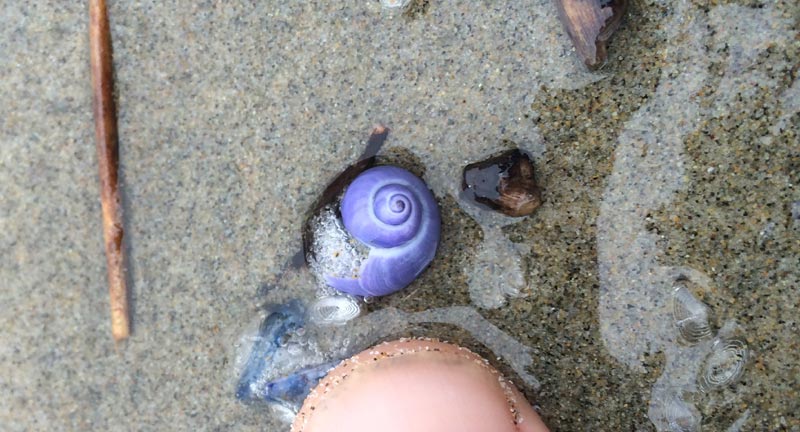Janthina / Violet Snails: Tiny, Rare Purple Weirdos of Oregon Coast
Published 03/03/2020 at 3:28 PM PDT
By Oregon Coast Beach Connection staff

Includes exclusive listings; some specials in winter
In Cannon Beach:
Includes rentals not listed anywhere else
In Manzanita, Wheeler, Rockaway Beach:
Some specials for winter
In Pacific City, Oceanside:
Some specials for winter
In Lincoln City:
Some specials for winter
In Depoe Bay, Gleneden Beach:
Some specials for winter
In Newport:
Look for some specials
In Waldport
Some specials for winter
In Yachats, Florence
Some specials for winter
(Seaside, Oregon) – Back in the early part of the year, something quite rare washed up on the north Oregon coast. It was small (about an inch around), purple and it came in with a bunch of Velella velella. Tiffany Boothe of Seaside Aquarium photographed it and was rather astounded. (Photo above: Boothe of Seaside Aquarium).
“After years of searching I finally found this one on the south end of Cannon Beach,” she said.
They are what is known Janthina janthina, otherwise known as the Violet Snail, Storm Snail or even just the common purple snail. Yet there’s nothing really that common about them here on the west coast of the U.S. In fact, no one in Oregon really knows much about them, although they are purportedly fairly common out to sea, by some accounts. Oregon Coast Beach Connection tried contacting experts at Newport’s Hatfield Marine Science Center, Oregon Coast Aquarium, Oregon Department of Fish and Wildlife and the Charleston Marine Life Center, but no one had any answers. Seaside Aquarium and the Scripps Institution of Oceanography in San Diego had a few, but still much remains a mystery about these critters when it comes to the Oregon coast.
One thing is commonly known, however: they rarely wash up here. And even if they do, they come ashore along with Velella velella (purple sailors), which are the prey of the Janthina. Then, because of their color and diminutive size they are hard to find.
It takes the same conditions that bring in the Velella, Boothe said.
“You'll need a west wind and a keen eye to find this pelagic sea snail,” she said. “Storm snails (Janthina janthina) also known as violet snail float on the surface of the sea using a bubble raft created by trapped air. As they float along the surface of the sea they feed on large hydrozoans, such as Velella velella or in warmer waters the Portuguese Man o' War. Along the west coast they have been found from Hawaii to Cape Flattery, Washington, but they can also be found in both the Atlantic and Indian oceans.”
It seems they tend to stick to warmer waters, and no one had any answers about how common or uncommon they are off Oregon waters. However, Humboldt State University in northern California did have some documentation about them showing up in that area and how unusual that was. Scientists there believe the Janthina regularly stick to warmer waters and got tricked into popping up there by warmer currents that lasted longer than usual.
Mark Ohman, Professor and Curator of Pelagic Invertebrates at Scripps Institution of Oceanography had some ideas on their frequency, however.
“Although Janthina and Velella beach only rarely, usually with persistent onshore winds, at times they can be common in the coastal ocean,” he said. “Keep your eyes peeled when you're out at sea.”

In the photo above (courtesy Boothe of Seaside Aquarium), you can just barely see the tiny Janthina around their prey, the Velella.
They’re also known for sticking together out at sea. Sometimes hundreds of them are connected while floating out on the surface, often via the “bubble raft” they create by secreting mucus that hardens and forms into a kind of flotation device.
“During favorable conditions these snails can be found in large groups and when close to shore with a strong westerly wind they can end up stranded on the beach usually among their prey, Velella velella,” Boothe said. “They also have a paper-thin shell which breaks up easily in the surf.”
That’s partially what allows them to float. The shell is so thin it’s lighter than water. This holopelagic gastropod is considered somewhat unusual by scientists (holopelagic means it spends its whole life floating on the ocean, by the way).
“The raft traps air in chambers made of mucus and keeps the animals afloat,” Ohman said. “Without the raft, the snails would sink readily (even though their shells are much thinner and lighter than related snails that live on the sea floor, they are negatively buoyant). Drifting right at the sea-air interface lets them encounter their primary prey, Velella (the jellyfish-like Sailor-by-the-wind) and, in more tropical waters, Physalia (the Portugese Man O' War).”
The Janthina has a little foot that comes out and helps propel it in the water. That foot also secretes the mucus that forms the bubble raft. If that raft fails and it sinks, as Ohman discussed, the creature dies in the deep and can’t come back up.
That it eats jellyfish is another real curiosity – and how it does so.
“When Janthina encounters its prey, it rasps away the soft prey tissue using a file-like structure called a radula,” Ohman said.
In turn, the Janthina are preyed upon by molluscs, birds, fish and even nudibranchs. Sometimes they have tiny barnacles attached to them from floating out at sea.
How they reproduce and go through their life cycle is another real oddity as well.
“Janthina are hermaphrodites, changing sex from male to female as they grow in size,” Ohman said. “Females secrete an egg mass that drifts along with the raft.”
As to their color, some have said it comes from eating the Velella, but that may not be entirely correct. According to some researchers in Australia, the color is an evolutionary thing. Their upside is more purple while the underside is darker, which camouflages them from above and from below.
Even after winter ends, springtime can still bring a lot of Velella as west winds occur along with minor storms. When the Purple Sails show up, that’s when you should go looking for their tiny enemy, the Janthina. Oregon Coast Hotels for this event - Where to eat - Map - Virtual Tour
Cannon Beach Lodging
Nehalem Bay Lodgings
Manzanita Hotels, Lodging
Three Capes Lodging
Pacific City Hotels, Lodging
Lincoln City Lodging
Depoe Bay Lodging
Newport Lodging
Waldport Lodging
Yachats Lodging
Oregon Coast Vacation Rentals
Oregon Coast Lodging Specials
Photo above by Charlie Plybon, Newport
More About Oregon Coast hotels, lodging.....
More About Oregon Coast Restaurants, Dining.....
LATEST Related Oregon Coast Articles
Purple sails, what looks like space junk, more. Marine Sciences
Explained: Strangely Colored Tides of Oregon / Washington Coast in Blue, Pink...
Ever walk the beach and discover the waves or the sea foam are a weird color? Marine sciences, Seaside Aquarium
The Mystery of Purple Waves on Oregon Coast Back in 2015
The whole strange science tale has another twist at its end, too. weather
Back to Oregon Coast
Contact Advertise on BeachConnection.net
All Content, unless otherwise attributed, copyright BeachConnection.net Unauthorized use or publication is not permitted
















































